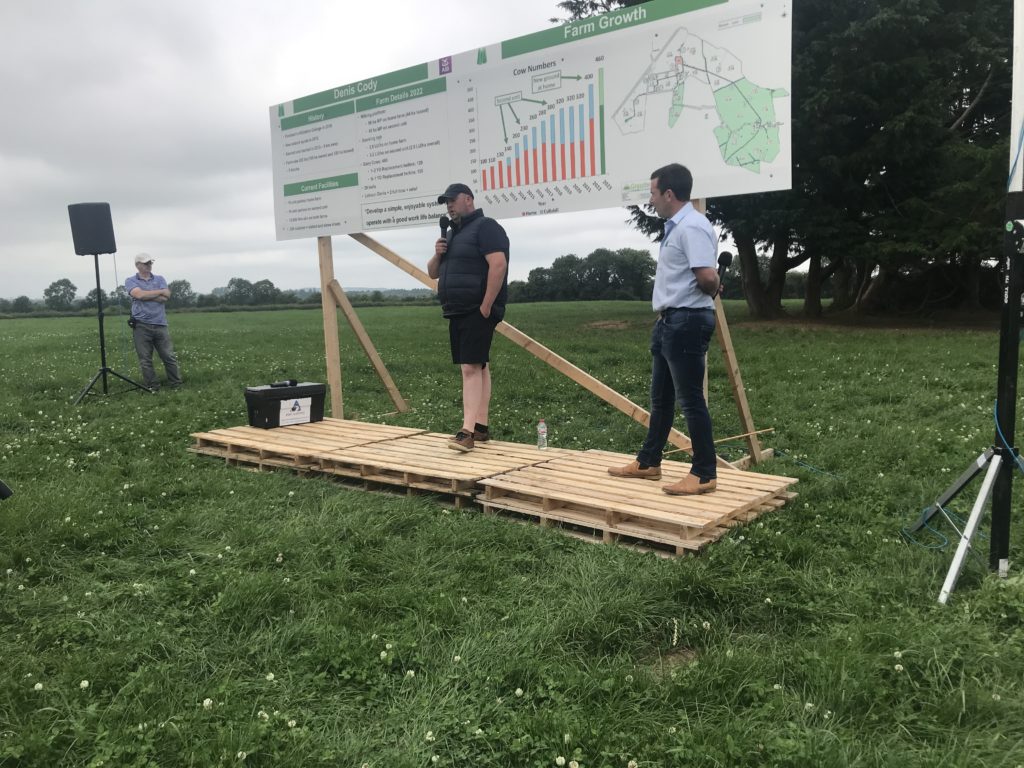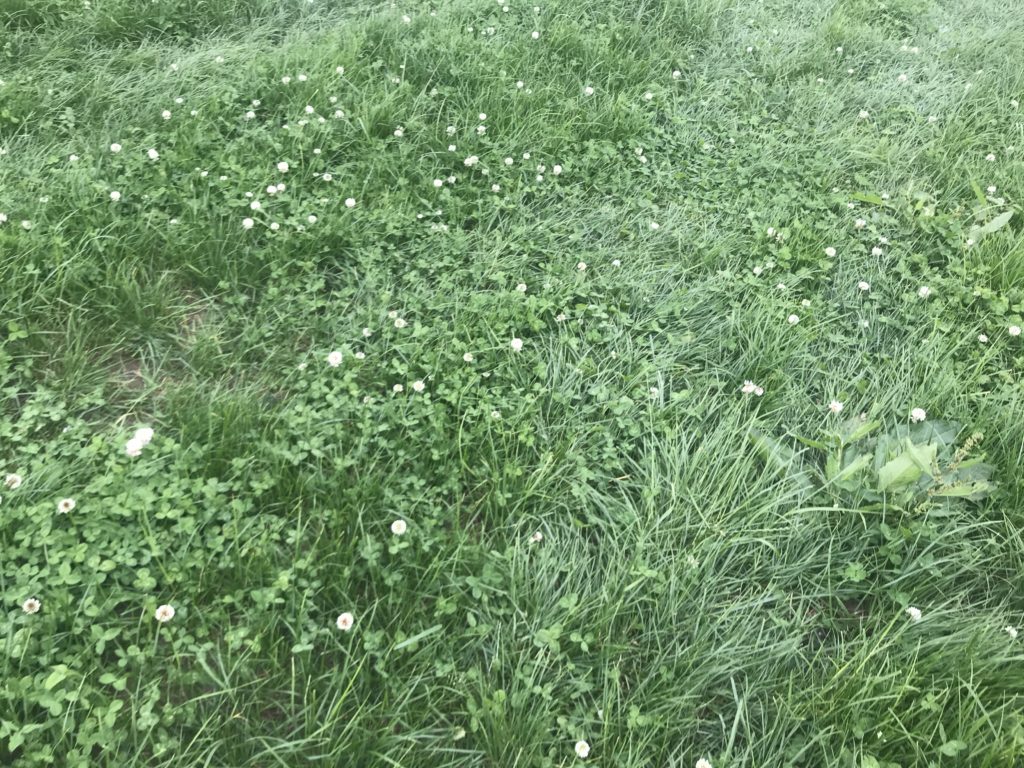Denis Cody has created a large dairy business on his Co. Tipperary farm after returning home from college to focus on dairy farming.
The second farm on the Irish Grassland Association (IGA) dairy summer tour brought the attendees to the Cody farm.
Denis farms with his wife Carmel and his parents Eamon and Anne, near Clonmore, Templemore, Co. Tipperary on two milking platforms, one 50% owned and the second 100% leased totalling 138ha.

Dairy Focus
The farm is operated as a mixed enterprise with a 100-cow dairy herd, a beef operation and tillage.
“There was no question about who was going to be the farmer in the family,” Denis told the crowd.
Denis wanted to focus on dairy and made a decision around education to obtain the best knowledge.
After school Denis attended Kildalton Agricultural college, returning home to farm in 2010 with a Level six diploma in dairying.
“I wanted to learn from the best, so I made sure I got the best placements.
“I could have been home here every evening, but instead I went to two top farmers in Westmeath and Cork to learned from the best.”
When he returned home, Denis reseeded the 48ha home farm over three years and began building stock numbers.
A 100-cow Holstein herd was on the farm when Denis returned from college and Denis culled a large number of them in the first year.
He was looking for a more robust grass-based cow with the Holstein-type cow not suiting the system, but he did say that they were great cows for generating first crosses with Jerseys.
The herd expansion has happened from within the herd, with no stock purchased in.

In 2013, Denis leased a 21ha former dairy unit with a disused milking parlour approximately 7km from home to start a second unit.
Starting with 40 cows, two additional parcels of land adjoining it have been leased to create a 48ha second dairy farm, milking 150 cows on this block.
All cows are calved on the home farm, and cows moved from the home farm to the second unit from late February.
An additional 75ha of land is farmed in three separate sections to supply winter forage and rear all replacement heifers.
There are two full-time labour units, who have been with Denis for over 10 years, including himself and weekend and casual labour also brought in. The majority of machinery work contracted out.
The home farm has an 18-unit milking parlour, which Denis said is coming under pressure with 14 rows expected to go through it next year.
Denis said he has plans to construct a 20- or 24-unit milking parlour on the home block at the end of 2023.
Cow performance
In 2021, an additional 44ha blocked was leased to give a 90ha platform. In 2022 a total of 250 cows will be milked on this home platform.
Last year, 524kg milk solids was sold/cow (4.63% fat and 3.78% protein) to Centenary co-op, with approximately 750kg meal/head fed.
Denis noted that 250kg of meal is fed purely for cow flow and to keep staff happy.
The overall stocking rate is 2.5 livestock units (LU)/ha farmed, the milking platforms are stocked at 3.2 LU/ha and 2.8 LU/ha.
Denis has plans to increase the stocking rate on the home platform further to 3.2cows/ha which he believes is optimum for the farm.

All the early-calving cows are moved to the outside block and these cows are used to generate the replacement using sexed semen.
With these cows being the ideal candidates for sexed semen, the herd milking on the home block is then bred to beef with calves sold off farm.
They are bred using a fixed time artificial insemination (AI) programme, with 56% holding to first service this year. The heifers were also bred to a fixed time AI programme and a 56% conception rate was also achieved.
Over the coming years Denis wants to maintain cow numbers and improve performance from the herd.
The herd has an average economic breeding index (EBI) of €174, with a Jersey-looking cow bred to a Friesian and vice versa.
Grass
Last year the farms grew approximately 14t of grass dry matter/ha, with a grazing season of over 280 days.
Denis like many farmers has begun the clover journey, with over-sowing completed on a number of paddocks this year.
All the grass decisions for both farms are made by Denis, with a grass walk completed every five days.
“I would eyeball the lower covers and cut and weigh the higher cover, it just quicken things up.
“The two lads would have no real interest in making grazing decisions, so I would tell the paddocks that cows are going to.”

Denis told the crowd that ideally he would like to have 11 paddocks on the farm, with cows spending 48hrs in each paddock.
With one paddock taken out for reseeding or bailing this would give him the 20-day rotation.
“We had it on the second block for a while where there [were] 12 paddocks and it just made it so simple,” he said.
Grass is the key to this farm with maximising the amount of grass in the cows’ diets a big focus on this farm.
Second unit
The second unit started small, but has increased to a 150-cow dairy farm with the addition of two more blocks of land.
Denis told the crowd that the addition of the two blocks has made that farm a viable second enterprise; without these blocks, he would likely not still be farming there.
Investments were made in grazing infrastructure not steel and concrete, with Denis noting that he was looking for the maximum return on investment.
“I invested in fencing, water and roadways to maximise my return on investment, the parlour was second-hand and nothing flashy.
“Steel and concrete was not going to give me a return on my investment.”
A 14-unit milking parlour and 15,000L bulk tank is on the second unit.
The second unit is run by one farm worker, with Denis doing the grass walks and relief milker.

Labour
Labour is an issue on many farms, with many farms struggling to attract and retain staff.
This is not the case on this farm with two full-time staff, who have been working on the farm for over 10 years.
Tommy has been working on the farm for 15 years and is actually on the farm longer than Denis. Mark has been working on the farm for 10 years.
Denis told the crowd there is no secret to attracting and retaining staff.
“Having good facilities, treating them with respect, and paying them well.”
During the busy calving period, a six and one rota is operated, this switches to an 11 and three for the rest of the grazing season and a five-day week is operated during the winter months.
Contractors are heavily used on the farm with all the silage, slurry and fertiliser spread by contractors.
Contractors are also used for a number of other jobs including dehorning calves, clipping cows’ tails and hoof pairing.
Future plans
Currently cows are wintered on six different farms, with all cows returned to the home farm to calf.
This does create issues Denis said if the weather is bad as housing is not where it is needed.
Denis said he has plans to construct more winter accommodation on the home farm and reduce the need for wintering cows on so many farms.
He wants to improve the herd further and continue to maximise grass in the cows’ diets.
Dairy Focus
To read more Dairy Focus articles on Agriland, click here.
